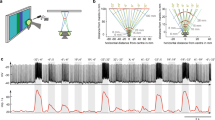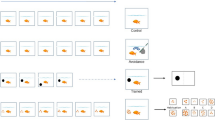Summary
The regional glucose utilization in the telencephalon of toadsBufo bufo during stimulation with different visual key stimuli was quantitatively mapped by means of the14C-2DG autoradiographic method: (i) a 4×28 mm2 worm-like stripe (W) eliciting prey catching responses, (ii) a 84×84 mm2 square (S) releasing predator avoidance responses, and (iii) a 28×4 mm2 antiwormlike stripe (A) eliciting no motor response.
Various telencephalic structures changed14C- 2DG uptake statistical significantly during stimulation with the above visual objects in comparison with binocular enucleated animals (brain-to-brain comparison) and in comparison between both hemispheres in monocular animals (interhemispherical comparison): (1) The ventral two-thirds of the posterior half of the medial palliumdecreased 14C-2DG uptake during W- and S-experiments, particularly in response to W. (2) In the posterior two-thirds of the lateral pallium,14C- 2DG uptake wasdecreased in response to the worm-, andincreased in response to the square (S) and antiworm stimuli (A). (3) The ventral striatumincreased uptake of14C-2DG during the animal's response to W- and S-stimuli significantly stronger than in the A-experiment. (4) The dorsal striatum also showed a significant change in14C-2DG uptake which, on a lower level, was not correlated with the type of stimulation experiment.
Various prosencephalic structures are involved in circuitries related to attentional phenomena and the gating of prey catching and predator avoidance behavior. The different functions of these structures are discussed.
Similar content being viewed by others
Abbreviations
- A :
-
anterior dorsal thalamus
- ACC :
-
nucleus ac-cumbens
- APL :
-
amygdala, pars lateralis
- APM :
-
amygdala, pars medialis
- aLP :
-
anterior third of the lateral pallium
- aMP :
-
anterior half of the medial pallium
- B :
-
Bed nucleus of the palliai commissure
- Ea :
-
entopeduncular nucleus, pars anterior
- dMP :
-
dorsal medial pallium
- dP :
-
dorsal pallium
- dSTR :
-
dorsal striatum
- La :
-
lateral thalamic nucleus, anterior division
- Lpd :
-
lateral thalamic nucleus, postero-dorsal division
- OT :
-
optic tectum
- P :
-
posterior thalamic nucleus
- pLP :
-
posterior two-thirds of the lateral pallium
- PO :
-
preoptic area of the hypothalamus;
- RET :
-
tegmental portion of the medial reticular formation
- SEP :
-
medial (MS) and lateral (LS) septum
- vMP :
-
ventral two-thirds of the medial pallium (MP)
- vSTR :
-
ventral striatum
References
Blankenagel F (1931) Untersuchungen über die Großhirnfunktionen von R.temporaria. Zool Jahrb 49:271–322
Chevalier G, Vacher S, Deniau JM (1984) Inhibitory nigral influence on tectospinal neurons, a possible implication of basal ganglia in orienting behavior. Exp Brain Res 53:320–326
Diebschlag E (1935) Zur Kenntnis der Großhirnfunktion einiger Urodelen und Anuren. Z Vergl Physiol 21:343–394
Ewert J-P (1967) Untersuchungen über die Anteile zentralnervöser Aktionen an der taxisspezifischen Ermüdung beim Beutefang der Erdkröte (Bufo bufo L.). Z Vergl Physiol 57:263–298
Ewert J-P (1968) Der Einfluß von Zwischenhirndefekten auf die Visuomotorik im Beute- und Fluchtverhalten der Erdkröte (Bufo bufo L.). Z Vergl Physiol 61:41–70
Ewert J-P (1984) Tectal mechanisms that underlie prey-catching and avoidance behaviors in toads. In: Vanegas H (ed) Comparative neurology of the optic tectum. Plenum Press, New York, pp 247–399
Ewert J-P (1986) Neuroethology: Toward a functional analysis of neural circuitries. In: Ellen P, Thinus-Blanc C (eds) Cognitive processes and spatial orientation. NATO-ASI Proceedings (in press)
Finkenstädt T, Ewert J-P (1985) Glucose utilization in the toad's brain during anesthesia and stimulation of the ascending reticular arousal system: A14C-2DG-deoxyglucose study. Naturwissenschaften 72:161
Finkenstädt T, Adler NT, Allen TO, Ebbesson SOE, Ewert J-P (1985) Mapping of brain activity in mesencephalic and diencephalic structures of toads during presentation of visual key stimuli: a computer assisted analysis of (14C)2DG autoradiographs. J Comp Physiol A 156:433–445
Gallistel CR, Piner CT, Allen TO, Adler NT, Yadin E, Negin M (1982) Computer assisted analysis of 2-DG autoradiographs. Neurosci Biobehav Rev 6:409–422
Groves PM, Thompson RF (1970) Habituation: A dual process theory. Psychol Rev 77:419–450
Gruberg ER, Ambros VR (1974) A forebrain visual projection in the frog (Rana pipiens). Exp Neurol 44:187–197
Grüsser O-J, Grüsser-Cornehls U (1976) Neurophysiology of the anuran visual system. In: Llinás R., Precht W (eds) Frog neurobiology. Springer, Berlin Heidelberg New York, pp 298–385
Herrick CJ (1948) The brain of the tiger salamander. University of Chicago Press, Chicago
Hore J, Vilis T (1980) Arm movement performance during reversible basal ganglia lesions in the monkey. Exp Brain Res 39:217–228
Kicliter E, Northcutt RG (1975) Ascending afferents to the telencephalon of ranid frogs: An anterograde degeneration study. J Comp Neurol 161:239–254
Kokoros JJ (1973) Efferent connections of the telencephalon in the toadsBufo marinus, and the tiger salamander,Ambystoma tigrinum. Doctoral thesis, Case Western Reserve University
Lettvin JY, Maturana HR, McCulloch WS, Pitts WH (1959) What the frog's eye tells the frog's brain. Proc Inst Radio Eng NY 47:1940–1951
Mata M, Fink DJ, Gainer H, Smith CB, Davidsen L, Savaki H, Schwartz WJ, Sokoloff L (1980) Activity-dependent energy metabolism in rat posterior pituitary primarily reflects sodium pump activity. J Neurochem 34:213–215
Mudry KM, Capranica RR (1980) Evoked auditory activity within the telencephalon of the bullfrog (Rana catesbeiana). Brain Res 182:303–311
Neary TJ, Wilczynski W (1980) Descending inputs to the optic tectum in ranid frogs. Soc Neurosci Abstr 6:629
Northcutt RG (1970) Pallial projection of sciatic, ulnar, and mandibular branch of the trigeminal afferents in the frog (Rana catesbeiana). Anat Rec 166:356
Northcutt RG (1974) Some histological observations on the telencephalon of the bullfrog,Rana catesbeiana. J Comp Neuroll 57:379–390
Northcutt RG, Kicliter E (1980) Organization of the amphibian telencephalon. In: Ebbesson SOE (ed) Comparative neurology of the telencephalon. Plenum Press, New York, pp 203–255
Northcutt RG, Royce GJ (1975) Olfactory bulb projections in the bullfrogRana catesbeiana. J Morphol 145:51–268
Rizzolatti G (1981) Mechanisms of selective attention in mammals. In: Ewert J-P, Capranica RR, Ingle DJ (eds) Advances in vertebrate neuroethology. NATO-AS1 Series. Plenum Press, New York, pp 261–297
Shinn EA, Dole JW (1978) Evidence for a role for olfactory cues in the feeding response of leopard frogs,Rana pipiens. Herpetologia 34:167–172
Sokoloff L, Reivich M, Kennedy C, DesRosiers MH, Patlak CS, Pettigrew KD, Sakurada O, Shinohara M (1977) The (14C)-deoxyglucose method for the measurement of local cerebral glucose utilization: Theory, procedure and normal values in the conscious and anesthetized albino rat. J Neurochem 28:897–916
Supin AY, Guse L'Nikov VI (1964) Representation of visual, auditory and somatosensory systems in frog forebrain. Fiziol Zh (Mosk) 50:426–434
Theurich M, Müller ChM, Scheich H (1984) 2-Deoxyglucose accumulation parallels extracellularly recorded spike activity in the avian auditory neostriatum. Brain Res 322:157–161
Wilczynski W, Northcutt RG (1983a) Connections of the bullfrog striatum: Afferent organization. J Comp Neurol 214:321–332
Wilczynski W, Northcutt RG (1983b) Connections of the bullfrog striatum: Efferent projections. J Comp Neurol 214:333–342
Author information
Authors and Affiliations
Rights and permissions
About this article
Cite this article
Finkenstädt, T., Adler, N.T., Allen, T.O. et al. Regional distribution of glucose utilization in the telencephalon of toads in response to configurational visual stimuli: a14C-2DG study. J. Comp. Physiol. 158, 457–467 (1986). https://doi.org/10.1007/BF00603792
Accepted:
Issue Date:
DOI: https://doi.org/10.1007/BF00603792




